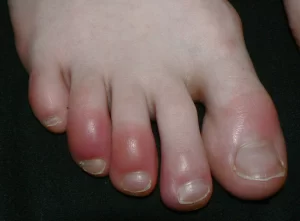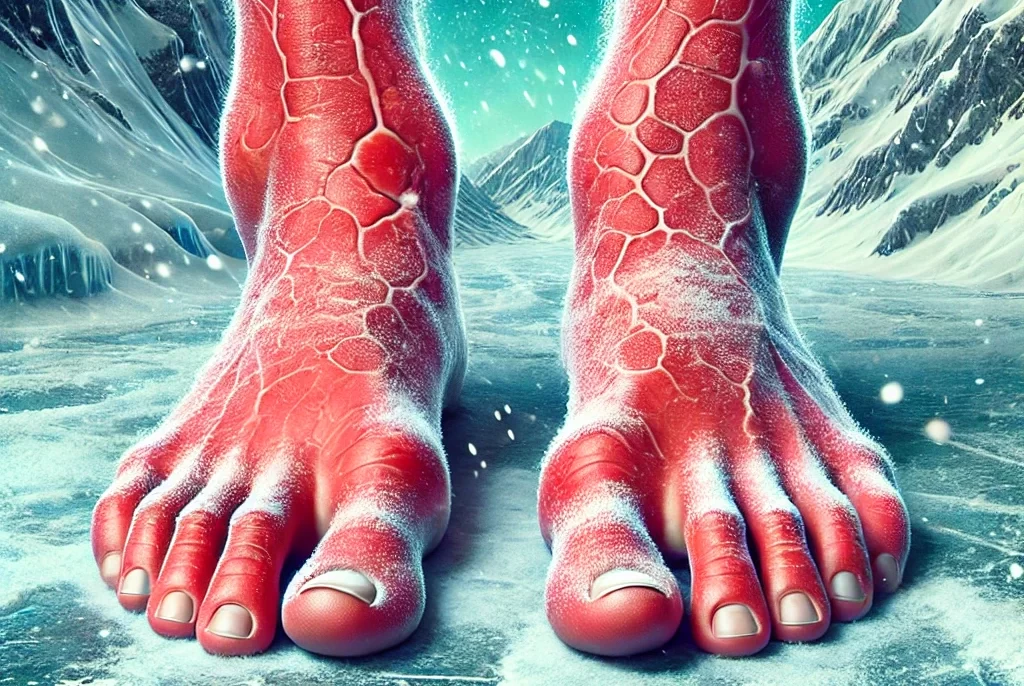Chilblains: Symptoms, Causes, Treatment, and Prevention
Chilblains, also known as pernio, are small, itchy, red swellings on the skin that develop after exposure to cold temperatures. While generally not serious, chilblains can be uncomfortable and may lead to complications if untreated.
Symptoms of Chilblains
Chilblains typically develop on extremities such as the toes, fingers, heels, ears, and nose. Symptoms usually manifest several hours after exposure to cold. Common symptoms include:
- Itchy or Burning Sensation: The affected areas often burn, itch, or sting, especially when transitioning to a warm environment.
- Red or Blue Discoloration: The skin may turn red or blue.
- Swelling: Mild to moderate swelling is common.
- Blisters and Sores: In severe cases, the skin may blister or form open sores.

Important Note: Avoid scratching, as it can lead to skin breakage and increase the risk of infection.
When to See a Healthcare Professional
While chilblains often improve on their own within a few weeks, you should consult a doctor if:
- The affected area does not heal after 2-3 weeks.
- Pus is present, or there are signs of infection.
- You experience high fever, chills, or feel generally unwell.
- You have diabetes, as foot problems can become severe.
- You repeatedly suffer from chilblains or have severe symptoms.
Causes of Chilblains
Chilblains result from an abnormal reaction to cold temperatures. When exposed to cold, blood vessels near the skin’s surface constrict. If the skin warms too quickly, these vessels may not adapt to increased blood flow, causing leakage into nearby tissue and resulting in swelling and itchiness.
Common Risk Factors Include:
- Poor Circulation: Reduced blood flow increases susceptibility.
- Family History: Genetics may play a role.
- Exposure to Cold, Damp, or Drafty Conditions: Prolonged exposure to harsh environments raises risk.
- Certain Medical Conditions: Lupus, Raynaud’s phenomenon, and low body weight.
- Smoking: Nicotine narrows blood vessels, increasing risk.
- Pressure on Feet: Tight shoes or bunions may lead to chilblains on the feet.
Treating Chilblains
Home Remedies for Relief:
- Apply Soothing Lotions: Calamine lotion or witch hazel may help alleviate itching. Consult a pharmacist for advice.
- Regular Moisturization: Use moisturizers to keep the skin hydrated and reduce itching.
Medical Treatment:
For severe or recurring cases, a doctor may prescribe nifedipine. This medication helps relax and widen blood vessels, improving circulation and reducing symptoms.
Tips for Preventing Chilblains
If you are prone to chilblains, take steps to reduce your risk:
- Avoid Sudden Temperature Changes: Gradually warm your skin after exposure to cold. Avoid placing cold feet or hands directly into hot water.
- Stop Smoking: Nicotine constricts blood vessels, increasing susceptibility.
- Stay Active: Regular movement improves circulation.
- Dress Warmly: Wear layers, insulate hands, feet, and legs with socks, boots, gloves, and leg warmers.
- Warm Shoes: Pre-warm shoes before wearing them, but ensure they are not too hot.
- Eat Hot Meals: Eating at least one hot meal a day can help maintain overall body warmth.
Additional Tips for Diabetes Patients: Regularly check your feet or ask someone to assist you, as you may not feel injuries that can become infected.
Complications of Chilblains
Severe or recurring chilblains can lead to:
- Infections: Open blisters or scratches may become infected.
- Ulcers and Scarring: Persistent skin damage may result in permanent discoloration or scarring.
Avoid Complications By:
- Not Scratching or Rubbing: This can worsen the condition and lead to infections.
- Avoiding Direct Heat: Gradual warming is essential.
- Keeping Skin Clean: Clean any breaks in the skin with antiseptic and cover with an antiseptic dressing. Change the dressing every other day until healed.
For persistent or worsening symptoms, seek medical advice to prevent complications and receive appropriate treatment.







